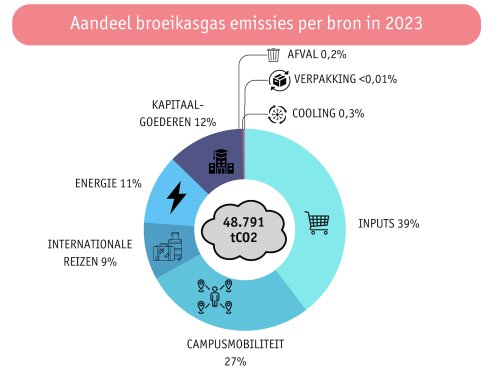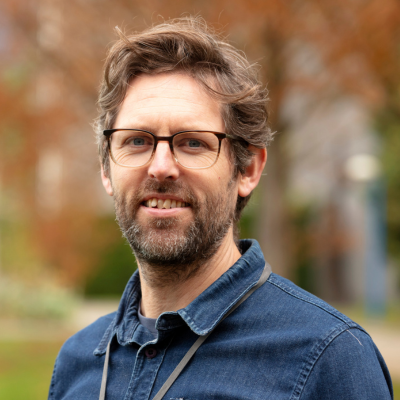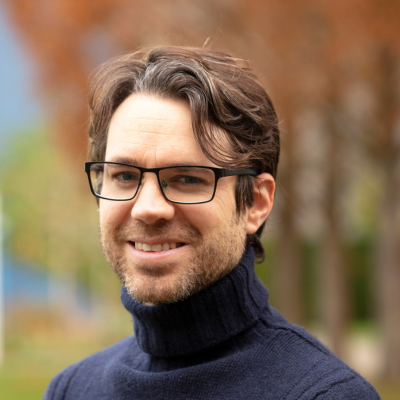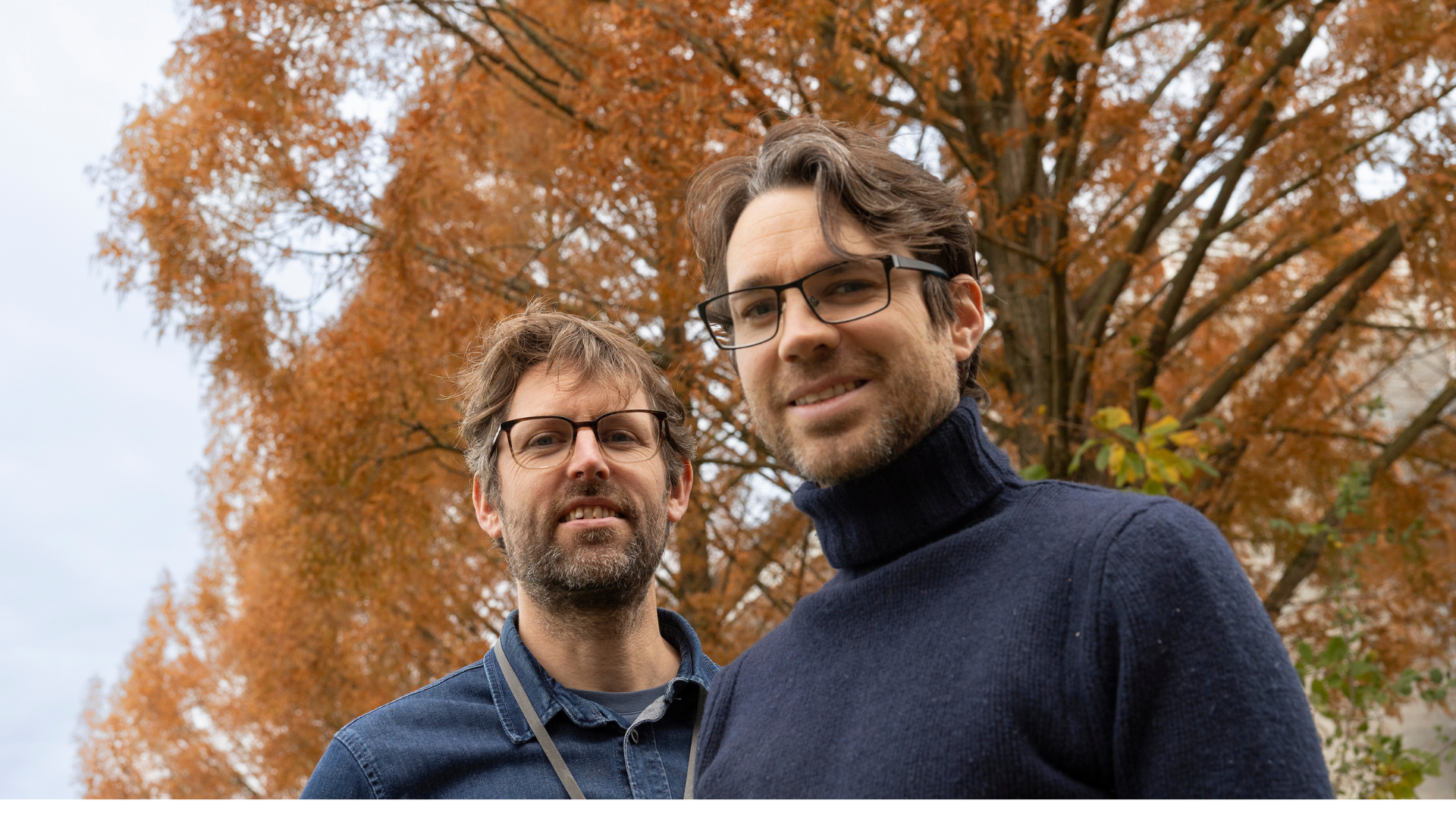Our university cut its CO₂ emissions by 16.5 per cent in five years. A solid result, but we aren’t on track yet to meet our targets. Although many services and departments are already on board with the climate agenda, we still need to step things up: ‘The collective support is there; now’s the time to turn that into action.’
With the climate clock ticking ever louder – and national and international ambitions often overtaken by daily concerns – there seems little reason for optimism. But Matthias Verstraeten of the Institute of Environment and Sustainable Development (IMDO) and Simon Geerts of the Environment Office prefer to focus on the opportunities, which they assure us are there.
‘As a university, it’s our responsibility to lead by example in reducing greenhouse-gas emissions,’ says Matthias. ‘Our aim is to be climate-neutral by 2030, with a 55 per cent CO₂ reduction, and to be free of fossil fuels by 2050. The 16.5 per cent reduction we’ve already achieved is good, but we need to do even better. To stay on course for 55 per cent, we should already be at 24 per cent.’
Climate Team
The university’s climate efforts got a boost in 2018 with the launch of the Climate Team: a bottom-up action group aiming to make our university climate-neutral as swiftly as possible. Several working groups were created around themes such as food, mobility, waste and circularity, and a climate action plan was drawn up.
‘What’s exciting about the Climate Team is that it brings together people from across the university to talk to one another. We’ve built a wide network and we know what’s going on. At first it was entirely volunteer-driven; by now, two permanent staff members have been hired,’ Matthias continues.
Baseline measurement
In 2018 an external consultancy ran a baseline measurement, calculating our university’s CO₂ footprint. The exercise was repeated in 2023, this time in-house by the Environment Office. Simon: ‘The new measurement is broader, with fresh emphases. Whereas we used to focus mainly on energy and mobility, we now looked at “inputs”: all the products and services the university purchases each year.’ From now on, a measurement will take place every two years, providing the basis for policy adjustments by the university.

The largest source of CO₂ emissions at UAntwerp is, by far, the purchase of products and services (39%), followed at some distance by commuting by staff and students (27%), and energy for heating and materials for the construction of new buildings (23%).
Most of the progress between 2018 and 2023 came from switching to 100 per cent green electricity. ‘That was low-hanging fruit; we won’t be making another leap like that any time soon. The road ahead is challenging, with a sizeable gap between ambition and reality. Other universities face the same issue, but I’m convinced there are still opportunities,’ Matthias explains.
Long-term strategy for building stock
The biggest financial challenge is our building stock. Considerable investment is needed to make our – partly ageing – buildings energy-efficient and, in time, fossil-free. ‘First and foremost we need a long-term strategy,’ says Matthias. ‘That means analysing future needs for research and education, and what our buildings can offer. We should also look at how we can make flexible working more comfortable and more widespread.’ Simon points to the refurbished Building B on Stadscampus as a good example of this.
Purchasing is another area where the team wants to move forward. Simon: ‘We need to factor in the CO₂ impact of products more explicitly, and extend product lifetimes – like we’re doing with ICT equipment, for example. Our ICT colleagues already choose to use laptops and monitors for as long as possible.’ A new challenge is the organisation-wide use of AI. Simon: ‘A new working group will coordinate that. But it’s also about awareness: what is the environmental impact of extra server capacity, and where in the world is it located?’
Matthias: ‘From January, the university also plans to adopt the Laboratory Efficiency Assessment Framework (LEAF), developed by University College London to improve efficiency in laboratory-based research and education.’

“A new challenge is the organisation-wide use of AI. What is the environmental impact of extra server capacity, and where in the world is it located? A new working group will coordinate that.“
– Simon Geerts
Mobility: we’re doing well
When it comes to mobility, especially commuting, our university isn’t doing too badly at all. Only 22 per cent of staff travel to campus by car, compared with 67.5 per cent across the whole of Flanders. Various initiatives were launched in this area, including a systematic analysis of travel behaviour and the provision of lease bikes. Parking policy is under review too. Matthias: ‘At present most car parks are freely accessible to everyone. You could limit access based on distance from home, for instance.’
Our university’s approach to international travel is also leading by example. ‘International trips are part of academic life, but we ask everyone to reflect: is this journey truly necessary? If so, can I take the train? For distances that can be covered by train in under eight hours, we ask people to actually choose that option. When flights are booked, we charge a CO₂ contribution to fund climate-friendly investments,’ Matthias explains. A project group on sustainability and internationalisation is exploring further actions.
“When it comes to mobility, especially commuting, our university isn’t doing too badly at all. Only 22 per cent of staff travel to campus by car, compared with 67.5 per cent across the whole of Flanders.”
– Mathias Verstraeten

Towards Sustainability label
Our university has also made progress on investments. Matthias: ‘We recently started applying the principles of the Towards Sustainability label. Professor Luc Van Liedekerke (Department of Management) was closely involved in developing this label with partners from the financial sector. We’re taking significant steps in this area.’
Food is another important domain. Although its share in our overall footprint is smaller, it remains a keyway to raise awareness, Simon believes. ‘Our komida team prioritises plant-based proteins, reusable packaging and seasonal vegetables. It’s paying off: 65 per cent of the meals we serve are vegetarian or vegan.’
Roadmap: where to next?
To target our efforts more effectively, the Climate Team wants to work with central services on a roadmap that lists concrete measures and their individual impact. That will clarify which actions are needed to meet our goals, although not all progress is easily captured in numbers. ‘Embedding sustainability in our education and research is hard to quantify, but it’s essential. We are, after all, a research and education institution,’ Simon notes.
There is more good news: for the first time, the new board has appointed a vice-rector for Sustainability, Steven van Passel. The Education Department has also set up a sustainability and education working group to examine whether sustainability features sufficiently in our study programmes. And the Board of Governors has approved all the objectives in the climate action plan. ‘That’s a significant commitment,’ says Matthias.
Working towards a climate-neutral university isn’t about choosing one thing over another, he concludes. ‘We need progress on all fronts to achieve our targets. The challenges are considerable, but seeing how many people remain tirelessly committed keeps me hopeful.’
If you also see climate and sustainability within our university as priorities, check out the programme for Climate Week, which runs until 21 November.
If you work in a lab or teach practicals and are keen to implement LEAF, get in touch with Simon or Matthias.


